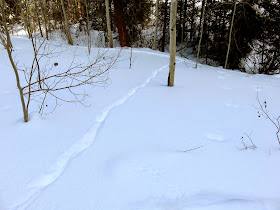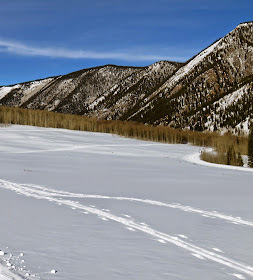Nature is a great teacher, an endless source of learning for those willing to pay attention and observe their surroundings. Footprints in the snow reveal a winter world alive with action, and by studying them we can determine not only the types of animals inhabiting this Rocky Mountain forest, but also the details of their daily lives.
Here's a little quiz, using the natural world as our outdoor classroom. Scenes A through H represent the comings and goings of various forest dwellers. Can you match the tracks with the animal who made them? The eight animals: Coyote, Mouse, Elk, Weasel, Human, Squirrel, Snowshoe Hare, Mule Deer.
 |
| A. The swish of a large tail between paw prints yields a clue as to this animal's identity. |
 |
| B. This long, straight trail is made by a heavier animal which makes more of an imprint on the snow. |
 |
| C. Known as a "perfect stepper" this animal carefully places its hind paws in the tracks made by its forepaws. |
 |
| D. Anything but a perfect stepper, this animal doesn't use stealth to attack its prey but rather uses frantic, quick, unpredictable movements. |
 |
| E. Another track made by a large and heavy animal. You can see how this animal lumbers through the snow, dragging its hind legs along behind the front ones. |
 |
| G. This animal's large hind feet make a deep impression in the snow when it hops from place to place. The hind feet land first, followed by the front paws. |
 |
| H. This animal is mostly a visitor to the forest, often for recreational purposes. During winter this creature often attaches aids to its feet which make it easier to walk and glide through the snow. |
Key to the quiz:
A. Squirrel
B. Mule Deer
C. Coyote
D. Weasel
E. Elk
F. Mouse
G. Snowshoe Hare
H. Human (Cross-country skis and poles made these tracks.)
How did you do on the exam? If you're lucky enough to have snow on the ground this weekend, take a winter hike and practice your observational skills to determine which animals share the outdoor classroom where you live.


That's a capital WOW!
ReplyDeleteI have heard that some trackers can even determine the age, sex and health of an animal, whether it's suffering from a disease or not. Comes from a deep understanding and watching the woods, I suppose.
This is truly an extraordinary post Rita
Your comment is spot on, Soumyendu.
DeleteIn his excellent book "Tracking and the Art of Seeing" author Paul Rezendes says "Tracking an animal is opening the door to the life of that animal. It is an educational process, like learning how to read."
The forest is speaking to us all the time, if only we take the time to listen.
Thanks again for following!
Hi Rita,
ReplyDeleteThis rather innovative posting is enjoyable and educational. Very nice job!
As for the quiz, my score wasn't perfect, but suppose it might get a "passing grade". Regardless, I thoroughly enjoy being a student in the "outdoor classroom" at all times of year, but especially during the Autumn and Winter months.
John
Glad to hear that you received a passing grade, John!
DeleteSpending time in the outdoor classroom is enjoyable indeed. I find that as I'm having fun in the out-of-doors there are almost always interesting things to observe and learn about.
Thanks for your kind words!
Hi Rita,
ReplyDeleteWhat a fun idea for a post! I'm not sure I would have done as well on the quiz without your hints, but I'm always fascinated by tracks in the snow - a season I'd rather be in hibernation than running around in the cold. :)
A friend from NH recently sent me a photo of porcupine tracks across his lawn. When I asked how he knew it was porcupine, he said, "Because they live under the barn!"
Well, your NH friend knows one way to identify tracks—by knowing which animals live on his property!
DeleteTracks in the snow are indeed fascinating; they present clear evidence that we're not alone out there in the woods.
Thanks for your comments, Vickie!
What a treat I found this post to be, Rita. I haven't had time to respond to my blog friends for a few days and had missed this fun quiz. I took it — scored 6 of 10, then gave it to my husband who scored 8 of 10, which seemed to delight him. If I were still teaching, I'd ask you to bring your quiz to my classes; I can think of any number of ways to tie it into most any curriculum.
ReplyDeleteThanks for sharing your scores on the quiz, and tell Joel I'm impressed with his 80%!
ReplyDeleteI wasn't sure which direction to take this post, but when I wrote the sentence about nature being a great teacher the quiz idea was born.
I'm sure that you were an amazing teacher, Janet, and I would have been delighted to have shared this post with your classes!